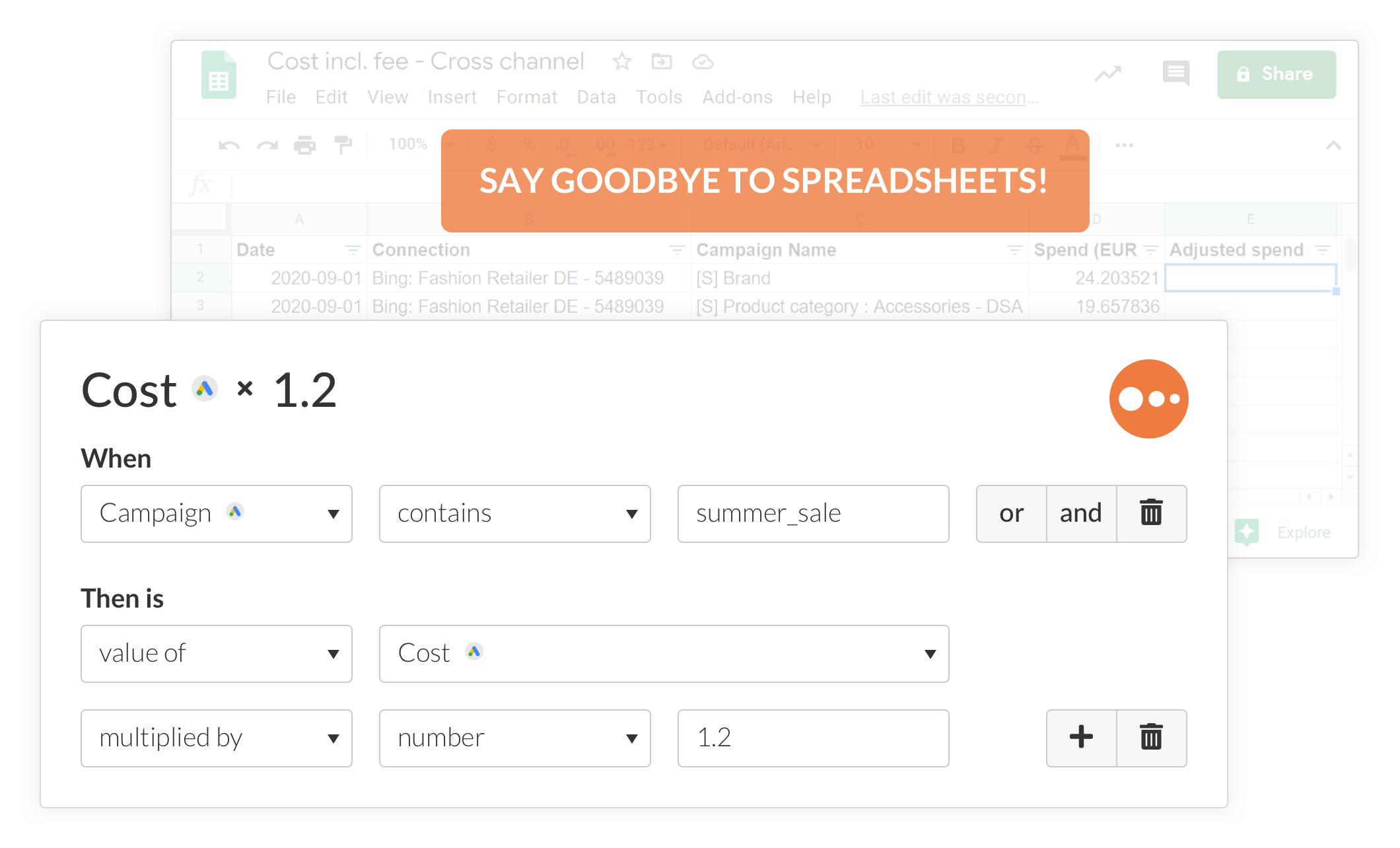Data has always been vital to marketers for optimizing their digital marketing campaigns - at least for the good ones.
In the 80s, David Ogilvy wrote that "advertising people who ignored research were like generals who chose to ignore enemy decodes." And is he wrong?
Armed with the right questions and the right data, one can crack the code for growth, customer retention, conversion optimization, user engagement, and more. In the end, you want to reach more potential customers.
While most of us don’t have a research department at our disposal, we do have something that Madison Avenue in the 80s could never dream of: a massive amount of data from our online marketing platforms.
Yet, are we using that data to our advantage? That becomes the business-critical question.
A Gartner study concluded that although marketing departments have staffed up their data analytics teams, those teams “still spend more time wrangling data than building insights.” Surveying over 500 companies to uncover how marketing teams use data, they discovered that 46% of data scientists were spending time preparing data for analysis.
If experienced and expensive analysts spend most of their time preparing data instead of analyzing it - that’s a considerable waste of talent and resources.
In our opinion, that’s a problem that shouldn’t exist in 2021 - carry on reading to find out why.
Data without context is just numbers
The average company uses eight marketing platforms in its digital marketing strategy.
It sounds like a lot - but think for a second.
For digital marketing, Google Ads and search is a must.
Facebook and Instagram are key for awareness within social media marketing.
Maybe Twitter.
Snapchat if your target audience is younger, and Linkedin if you’re doing B2B.
You’ll also need a display network for banners.
In short, marketing and digital channels add up quickly!
Each of these digital media provides you with tons of data. Think of cost, clicks, conversions, impressions, likes, shares. The list goes on. Now imagine manually putting a report together:
- Go into a platform.
- Download the data.
- Add to Excel or Google Sheets.
- Repeat for every channel.
When you've done that, only then does the actual work begin. It’s time to stitch everything together. And here is where things get trickier, as each platform may have different date formats, currency, or naming conventions.
Once you’ve stitched all the data together, cleaned every column, checked every row, is the data good to go. But, by then, you’ve already spent a good chunk of time on it. Now, the whole morning you had blocked to analyze data, just got cut to an hour before the lunch meeting you needed to prepare for it.
Can you see the problem?
Manually working with data from multiple sources is time-consuming and, to be honest, just plain dull. Nobody likes to perform repetitive work, and as the mind drifts, people become error-prone. Above all, you are more valuable when thinking about data, not copy-pasting data from one sheet to another.

Solving the problem
I hope by now, this post has brought you some memories about time wasted with data sheets or exchanging emails with your BI team.
You should be wondering if there are better ways for Marketing teams to deal with data.
Well, there are - and here are some of them!
Ignore the problem
Ignoring the problem is not a solution, but it’s a pretty common response.
For many marketers, this is just the way things are. They can put in some extra hours and keep complaining about it. Maybe, if things go right, they will even hire some junior staff and dump the tedious tasks. It’s short-sighted, dumb, and not a solution. But, it’s common.
If you’ve read so far, you're better than this and want to find a real solution. So let’s jump to the next one.
Create Excel/Google Sheets templates
Most of your marketing data will have some commonalities.
For example, often, the date column is the red thread through multiple datasets. Given that, you can create a template. Maybe it’s an Excel Notebook with numerous tabs, one for each marketing platform, where you will just copy-paste, and the main worksheet will aggregate everything together. Honestly, that might work, but it’s a house of cards: make an error on one of the tabs, and the whole thing falls apart. That's to say, it’s not scalable.
As a marketer, you want to test new things. Templates are, by definition, not built for experimentation.
Learn some coding
If you have the time, you can learn some Python or some R.
With a couple of lines of code, you can probably consolidate your data and make it ready for analysis. Of course, that will still require manually downloading each sheet individually, and you will become a bottleneck for the whole team (unless everyone learns to code).
Coding could become a basic skill for every marketer, but it will still require time and commitment.
Ask someone to build API connectors
Some companies have their own internal data ops teams that can create specific scripts and connectors to fetch marketing data from several APIs. Only advanced companies that make investments in data, though, can do this.
However, even if your marketing department works extremely close with this team, you most likely will face some roadblocks.
From experience at Funnel, we know that maintaining APIs is a time-consuming process, as things change all the time. And maybe you in the marketing department want to add new parameters, fetch more data, experiment.
Without a robust set of always up-to-date API connections, having the data-fetching process in the hands of another team will lead you to a situation where your marketing team lacks data independence - and that's something you want.
Implement Funnel to improve your marketing tactics
We've established that in a perfect world, marketers would spend more time on analysis instead of collecting data and being independent to work with such data.
That is what Funnel allows marketing teams to do. By integrating with virtually every platform, we can help you to keep your data ready for analysis at all times.
It should sound like no surprise, but we use Funnel daily, and here is why it makes our job as marketers easier:
1. Always have answers
Funnel helps us keep track of performance across all our marketing channels, so if our CEO has a question about how things are going, we can answer it with a couple of clicks.
2. Monitor cross-platform performance
For almost two years, the performance marketing team Funnel was just one person (me). I managed around eight platforms, keeping track of performance and feeding the sales team with high-qualified leads. Can you imagine the time for one person to monitor performance daily across all platforms?
With Funnel, I can check it in minutes and, if something is off, I can dig deeper.
3. Do deep investigations faster
At Funnel, Marketing and Sales work really close together, so whenever sales feel there is a variation in lead volume, they come to us.
With Funnel, we can pull cross-channel data for a given period extremely fast. This allows us to dig deep into platform-by-platform performance to find those answers for sales.
4. Experiment and explore
We try our best to keep experiments running at all times.
Maybe it’s a new targeting approach, or copy, or bidding strategy, whatnot. With Funnel, our data is always ready and adaptable to these experiments.
For example, we might need to tweak metrics or dimensions, change how data is combined in a dashboard, combine platforms differently. To do such changes is fast and effortless.
5. Own your data
Funnel has its data engineers and BI teams, which do an amazing job.
However, much as they are data wizards, they don’t know that much about marketing.
By having Funnel, we can work with massive amounts of data independently: label data with custom dimensions, create our KPIs with custom metrics and export them anywhere we want.
We still work closely with BI, but we're independent.
Want to work smarter with marketing data?
Take a look at the Platform overview page to discover how a marketing data hub like Funnel helps both marketers and data teams.
There's a better way to do digital advertising
The best marketers know marketing is a numbers game.
They do their best to use all the available data to justify the investment, prove ROI, and improve performance.
Emotion, creativity, storytelling still matter and always will, of course, but the science of marketing is more relevant than ever.
Gone are the days of traditional marketing. Businesses that understand that - have a lot to gain. And those that empower their marketers with tools to analyze, understand and trust data will always be ahead in their marketing efforts - with better insights and strategies.
“The increased uncertainty in the new normal requires marketers to get better at testing and faster at reacting. A more agile operating model is a key element in this, but it is also increasingly necessary to work with technology that learns at scale.” - The big reset: Data-Driven marketing in the next normal, McKinsey & Company.
And here lies the opportunity.
We're in a curious moment, where marketers are just starting to unleash the power of data.
Of course, Big Data, AI, and Machine Learning have existed for decades, but what I’m referring to is simpler.
It’s the untapped potential of giving marketers the tools to make quick and fast analyses on the go. To not be bored by repetitive manual work.
And above all, to inform their decisions on data and not hunches.
Up next: What is data storytelling, and how can it make your presentations magical?
